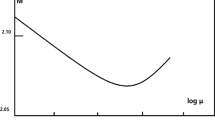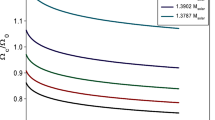Abstract
In the present paper we have studied the eigenfrequencies of small adiabatic barotropic pseudo-radial and nonradial modes of oscillations of the white dwarf models of rotating stars in binary systems. In this work the methodology of Mohan and Saxena (in Astrophys. Space Sci. 113:155, 1985) has been used that utilizes the averaging technique of Kippenhahn and Thomas (in Proc. IAU Colloq., vol. 4, p. 20, 1970) and certain results on Roche equipotential as that given by Kopal (in Advances in Astronomy and Astrophysics, Academic Press, 1972). The objective of this study is to investigate the effects of rotation and/or tidal distortion on the periods of oscillations of rotationally and/or tidally distorted white dwarf models of stars assuming it to be the primary component of the binary system and rotating uniformly. The results of present study show that the eigenfrequencies (both radial and nonradial modes) of the rotationally distorted and rotationally and tidally distorted white dwarf model of stars in binary systems tend to decrease under the influence of rotational distortions and rotational and tidal distortions, respectively. However, results are contrary for tidally distorted white dwarf model of stars.



Similar content being viewed by others
References
Althaus, L.G., Corsico, A.H., Isern, J., Garcia-Berro, E.: Astron. Astrophys. Rev. 18, 471 (2010)
Baglin, A., Schatzman, E.: Low-Luminosity Stars, p. 385. Gordon and Breach, New York (1969)
Brassard, P., Fontaine, G., Wesemael, F., Tassoul, M.: Astrophys. J. Suppl. Ser. 81, 747 (1992)
Chandrasekhar, S., Lebovitz, N.R.: Astrophys. J. 140, 1517 (1964)
Chelbowski, T.: Acta Astron. Astronomica 28, 441 (1978)
Degregoria, A.J.: Astrophys. J. 217, 175 (1977)
Domiciano de Souza, A., Kervella, P., Jankov, S., Abe, L., Vakili, F., di Folco, E., Paresce, F.: Astron. Astrophys. 407, 47 (2003)
Durney, B.R.: Nature 219, 20 (1968)
Fontaine, G., Brassard, P.: Publ. Astron. Soc. Pac. 120, 1043 (2008)
Fuller, J., Lai, D.: Mon. Not. R. Astron. Soc. 412, 1331 (2011)
Gribbin, J.R.: Appl. Phys. Lett. 4, 77 (1969a)
Gribbin, J.R.: Mon. Not. R. Astron. Soc. 144, 549 (1969b)
Hansen, B.M.S., Leibert, J.: Annu. Rev. Astron. Astrophys. 41, 465 (2003)
Harper, R.V.R., Rose, W.K.: Astrophys. J. 162, 963 (1970)
Horn, H.M.V., Richardson, M.B., Hansen, C.J.: Astrophys. J. 172, 181 (1972)
Hurley, M., Roberts, P.H., Wright, K.: Astrophys. J. 143, 535 (1966)
Kippenhahn, R., Thomas, H.C.: A simple method for the solution of the stellar structure equation including rotation and tidal forces, stellar rotation. In: Slettebak, A.D. (ed.) Proceedings of IAU Colloq, Ohio State Univ, Columbus, vol. 4, p. 20. Gordon and Breach, New York (1970)
Koester, D.: Astron. Astrophys. Rev. 11, 33 (2002)
Kopal, Z.: Advances in Astronomy and Astrophysics, vol. 9, p. 1. Academic Press, New York (1972)
Kumar, T.: Mathematical modeling of rotationally and tidally distorted pulsating white dwarfs stars. M.Sc. Thesis, Thapar University, Patiala, Punjab, India (2010)
Lal, A.K.: Structure oscillations and stability of differentially rotating and tidally distorted stellar models. Ph.D. Thesis, University of Roorkee, Roorkee, India (1993)
Lal, A.K., Mohan, C., Singh, V.P.: Astrophys. Space Sci. 301, 51 (2006)
Mohan, C., Agarwal, S.R.: Astrophys. Space Sci. 129, 73 (1987)
Mohan, C., Saxena, R.M.: Astrophys. Space Sci. 113, 155 (1985)
Mohan, C., Saxena, R.M., Agarwal, S.R.: Astrophys. Space Sci. 178, 89 (1991)
Mohan, C., Lal, A.K., Singh, V.P.: Indian J. Pure Appl. Math. 29(2), 199 (1998)
Osaki, Y., Hansen, C.J.: Astrophys. J. 185, 277 (1973)
Ostriker, J.P., Tassoul, J.L.: Astrophys. J. 155, 987 (1969)
Papaloizou, P., Pringle, J.E.: Mon. Not. R. Astron. Soc. 182, 423 (1978)
Popper, D.M., Plavec, M.: Astrophys. J. 205, 462 (1976)
Roxburgh, I.W., Durney, B.R.: Z. Astrophys. 64, 504 (1966)
Sauvenier-Goffin, E.: Ann. Astrophys. 12, 39 (1949)
Saxena, R.M.: The effects of rotation and tidal distortions on the structure and periods of small oscillations of gaseous spheres. Ph.D. Thesis, University of Roorkee, Roorkee, India (1984)
Schatzman, E.: Ann. Astrophys. 24, 237 (1961)
Singh, K.: Nonradial oscillations of gaseous spheres. Ph.D. Thesis, University of Roorkee, Roorkee, India (1976)
Singh, H.P.: Astron. Astrophys. 259, 155 (1992)
Singh, H.P., Das, M.K.: Astrophys. Space Sci. 186, 117 (1991)
Spruit, H.C.: Astron. Astrophys. 349, 189 (1999)
Spruit, H., Phinney, E.S.: Nature 393, 139 (1998)
Tassoul, M., Fontaine, G., Winget, D.E.: Astrophys. J. Suppl. Ser. 72, 335 (1990)
Winget, D.E., Kepler, S.D.: Annu. Rev. Astron. Astrophys. 46, 157 (2008)
Author information
Authors and Affiliations
Corresponding author
Appendices
Appendix A: Series solution at the center and surface for Eq. (2.1)
Using Eq. (2.3a) the series solution at centre x=0 for Eq. (2.1) can be written as
where

The series solution at surface x=1 for Eq. (2.1) becomes
where

and
Here the symbols have same meaning as given in the manuscript.
Appendix B: Method for determining the eigenfrequencies of nonradial oscillations using Chebyshev polynomial expansion technique
The eigenvalue problem that determines the effects of rotation and tidal distortions on the eigenfrequencies of nonradial modes of oscillations of rotationally and tidally distorted stellar models is governed by the set of differential equations (3.1) together with the boundary conditions (3.2), (3.3a), (3.3b). This eigenvalue problem does not yield analytical solutions even for simple density distribution laws. In this appendix we present a method based on the use of Chebyshev polynomial expansions which can be used to solve such problems.
Hurley et al. (1966) were perhaps the first to use Chebyshev polynomial expansion to obtain the eigenfrequencies of various nonradial modes of oscillations of polytropic models. Later on, the same technique with slight modifications was used by Singh (1976), Saxena (1984) and Lal (1993) to compute the eigenfrequencies of nonradial oscillations of various stellar models. The Chebyshev polynomial expansion may be explained as follows.
Chebyshev polynomials are orthogonal polynomials related to the trigonometric functions. A simple way to define a Chebyshev polynomial T n (x) of order n is given by the relation T n (x)=cos(nθ), where θ=cos−1 x.
In Chebyshev polynomial expansion technique, the unknown functions are represented as linear combinations of Chebyshev polynomials containing a number of unspecified expansion parameters. The substitution of these expansions of unknown functions in the set of differential equations converts the problem of solving the set of linear differential equation into the problem of solving a set of linear simultaneous algebraic equations.
In order to solve the system of differential equations (3.1) with the boundary conditions (3.2), (3.3a), (3.3b), the system of equations together with the boundary conditions are transformed using the substitution x=(z+1)/2 (−1≤z≤1) so that the range of integration is renormalized from (0,1) to (−1,1). The above substitution transforms the set of Eqs. (3.1) to the form
where B 1,B 2,B 3,E 1,E 2 etc. are same as defined in (3.1) with x replaced by (z+1)/2. Now, we assume Chebyshev polynomial expansions for \(\frac{d\zeta}{dz}, \frac{d\eta}{dz}\ \mathrm{and}\ \frac{d^{2}\kappa}{dz^{2}}\) truncated after ‘m’ terms as
where a j ,b j (j=2,3,…,m+1) and d j (j=3,4,…,m+2) are unknown expansion parameters and T j (z)=T j (cosθ)=cos(jθ). Integrating the above expression analytically, we get

where a 1,b 1,d 1 and d 2 are constants of integration.
Substituting above expressions in the system of differential equations (B.1), we get three algebraic equations that contain a 1,a 2,…,a m+1,b 1,b 2,…,b m+1 and d 1,d 2,…,d m+2, that is, in all 3m+4 unknown expansion parameters. To evaluate these unknown parameters, the above equations may now be forced to be satisfied at m collocation points in the range of integration. Zeros of Chebyshev polynomials of order m are often preferred as the collocation points. On satisfying the above equations at m collocation points in the range of integration we get 3m linear algebraic equations in 3m+4 unknown expansion parameters. Now, if we add to these 3m equations, the four linear equations which can be obtained from the four boundary conditions (3.2), (3.3a), (3.3b) by converting them to Chebyshev polynomial expansion forms, we get a set of 3m+4 linear homogeneous algebraic equations in as many unknowns.
In order to determine the eigenfrequencies an approach similar to one followed by Singh (1976) may now be used. In this approach we withhold one of the boundary conditions and replace it by a normalization condition which assigns a non-zero value to one of the unknown eigenfunction ζ or η at the center or the surface of the model. The withhold boundary condition is now used as a discriminant condition for determining the value of the nondimensional eigenfrequency ω 2. Trials with different values of ω 2 are made till a value of ω 2 is found which satisfies the withheld condition to the desired accuracy. In the present work, we have used ζ=1 at the center as normalization condition and the boundary condition (3.3a) at the surface as the discriminant condition. The set of linear algebraic simultaneous equations have been solved using Gaussian elimination method with pivotal condensation.
Rights and permissions
About this article
Cite this article
Lal, A.K., Kumar, T. & Pathania, A. Eigenfrequencies of rotationally and tidally distorted white dwarf models of stars. Astrophys Space Sci 345, 155–167 (2013). https://doi.org/10.1007/s10509-013-1362-0
Received:
Accepted:
Published:
Issue Date:
DOI: https://doi.org/10.1007/s10509-013-1362-0




